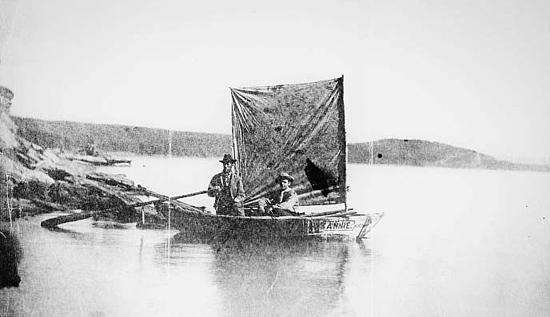
Annie, the first boat on Lake Yellowstone, Hayden Expedition, 1871, Photo by Wm. H. Jackson
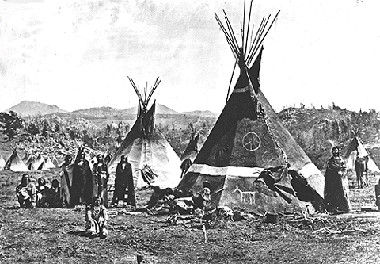
Shoshoni encampment, Wind River Basin, photo by Wm. H. Jackson, Library of Congress.
Much has been written of the Hayden Expedition to Yellowstone. It was as a result of the
expedition that the area was designated as the world's first national park. Credit
belongs not alone to one. Hayden had the foresight to include a photographer to
document his findings. Photography in the field was difficult involving literally a
wagon load of glass plates, chemicals, and a portable dark room. A photograph could
take 45 minutes to take and in some instances all day. Neither Washburn in his earlier expedition, not Powell in his
his first expedition down the Green River had included a photographer. The photographs alone
would not have been sufficient to convince Congress to designate the park. For
while they provide visual proof of the earlier claims of Bridger and Colter, they
could not provide all of the splendor of the area. It was Moran armed only with a
sketch pad, and his paintings, based on
pencil sketches and notes, which
provided the visual glory, indeed, to such an extent that Congress paid $10,000 for the
first landscape ever to be purchased by Congress. Not to be forgotten either should be Jay Cooke, who provided, in
the interests of Northern Pacific, the political and financial wherewithal necessary to
obtain approval for the Hayden Expedition, and Congressional approval for the
designation of the area as a National Park.
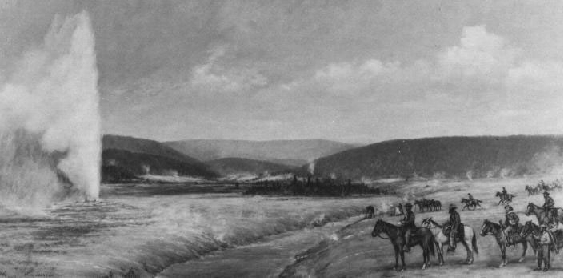
Hayden Expedition, Yellowstone, pencil by Thomas
Moran, 1871
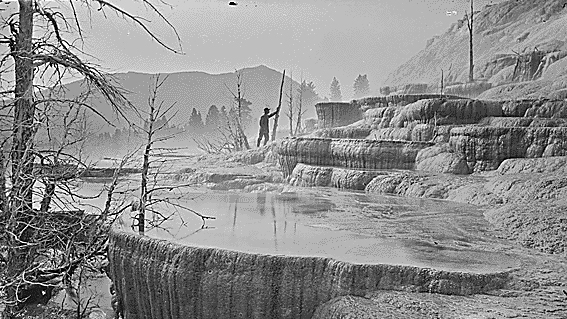
William H. Jackson at Mammoth Hot Springs, 1871
Hayden continued his expeditions to the west with another in 1872. In his expedition of 1873-1874 to Colorado, Hayden was the first Anglo-American
to observe the Black Canyon of the Gunnison in Western Colorado.
He pronounced it inaccessible.
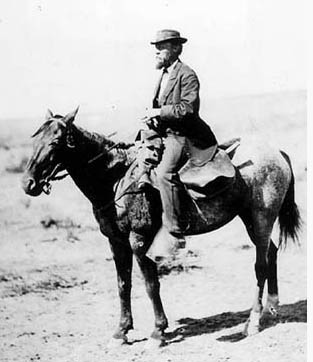 Ferdinand V. Hayden, 1871, Wm. H. Jackson
Ferdinand V. Hayden, 1871, Wm. H. Jackson
The 1870 expedition was not Hayden's first trip into Wyoming. Hayden was a part of a scientific contingent under
Gouverneur Kemble Warren in the military expedition into the Yellowstone and Powder River Country under the command of
then Col. Wm. S. Harney. The expedition was intended to punish the Sioux for the massacre of Lt. John L. Grattan and his Company. Grattan was attempting
to punish Indians for the butchering of a cow near Ft. Laramie. Harney, with a force of 600 men, came upon
the camp of Chief Little Thunder near what is now Lewellyn, Neb. When the Indians began to flee, Haney deceived Little Thunder
with a white flag of truce, then surrounded the camp, killing men, women and children. Warren reported:
"The sight . . . was heart-rending--wounded women and children crying and moaning, horribly mangled by the bullets." Two dead women
were found clutching their dead children. Thus ended the Battle of Blue Water Creek.
[Writer's note: Punitive expeditions against the Indians were nothing new with
Col. Harney. He previously served in the Seminole Wars in Florida. In 1840, he and
32 men were guarding a store at Indian Key. The store was attacked by Chekika and
Billy Bowlegs II. Eighteen of the troops were killed. Harney escaped wearing only his
underwear. Harney organized a unit of 90 soldiers disguised as Indians and
took Chekika and his men by surprise. Harney hanged Chekika and his men. In
retaliation, the Miccosukee medicine man Arepeika ordered all white captives
burned alive. The army ended its practice of hanging Indians. Arepeika was
never captured and died in his 90's in Florida's Big Cypress Swamp.] Hayden was by professional training a surgeon. His only practice, howver,
was during the Civil War for the Union Army.
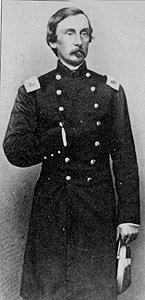
G. K. Warren Gouverneur K. Warren graduated second in his class from West Point
in 1850 and, thus, escaped from being placed on the faculty. Instead he was
assigned to the Corps of Topographical Engineers and in 1854 was given the task of compiling a comprehensive map of the
trans-Mississippi West. As a result, Warren made three surveys in Nebraska and Dakota, of which Wyoming was then a
part. His 1856 expedition into the Yellowstone and Powder River Country included Ferdinand Hayden, who was a protege of Spencer Baird,
a personal friend of Warren's. For his services, Warren offered Hayden either $200 for the expedition plus traveling expenses or
or an annual salary of $1000. At the end of the year Hayden wrote an article for
the National Intelligencer", to the annoyance of Warren, indicating that Hayden had received the
appointment independently of the miltary or Warren.
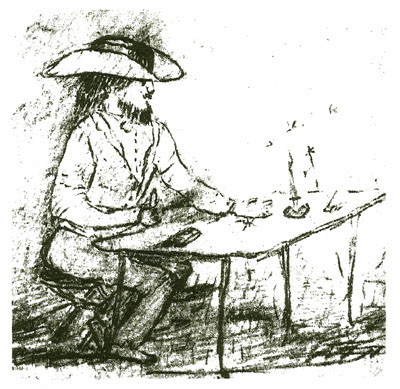
F. V. Hayden, Raynolds Expedition of 1858
The following year Warren published what is regarded as the first "reasonably accurate map of the American West". The same year, however,
on an expedition up the Loup Fork of the Platte a blow-up occurred between the two, with the risk to Hayden that he would be fired. The question of whether Hayden
would be allowed to return on the following year's expedition was resolved when Warren's father died and Warren, to
be closer to his family, accepted an appointment to the faculty of the Point. Capt. William F. Raynolds was assigned by Congress
with a budget, upon the recommendation of Warren, of $60,000 to explore the mythical Upper Yellowstone and locate a suitable wagon road.
Hayden remained with the expedition and continued to be an irritant. Raynold's expedition, guided by Jim Bridger, was plagued by snow and a mutiny.
Raynold's report, itself, was not published until 1868, but it provided for the
first time confirmation of Bridger's earlier claims and provided impetus for further exploration including Washburn's and
Hayden's expeditions. Although a specific wagon road route was not
located, several suggestions were contained in the report.
Beginning in 1853, proposals for a transcontinental railroad were put before Congress, which, however, was split along regional
lines between a northerly route and a southerly route. With the secession of the South, however, the issue was decided with the survey parties
of 1867-68 basing much of their work on Warren's map.
At the Battle of Gettysburg, Warren distinquished himself by saving the undefended Little Round Top, thus, turning the battle and
ending the Confederate threat to Harrisburg which would, in turn, have made the defense of Washington
difficult.
Next page Fort Washakie, Chief Washakie. |